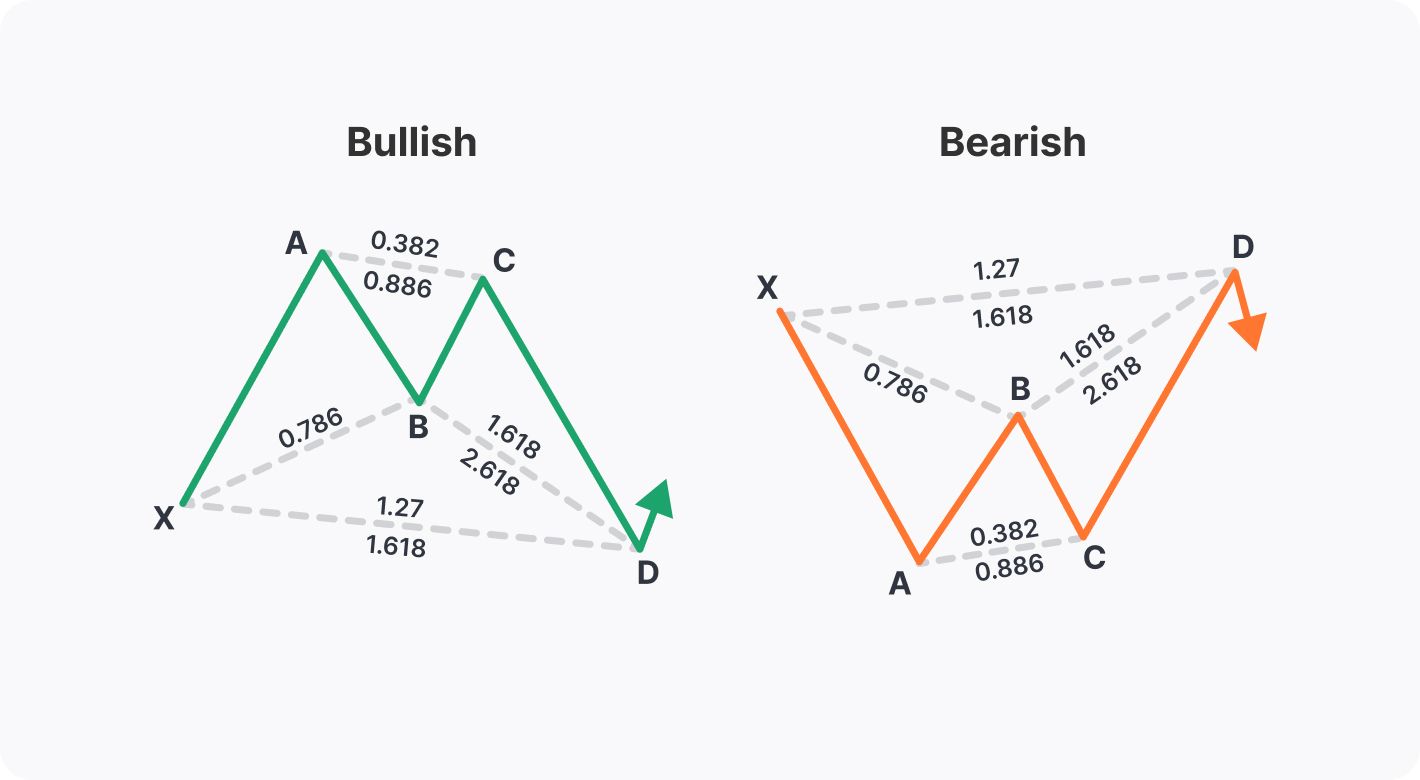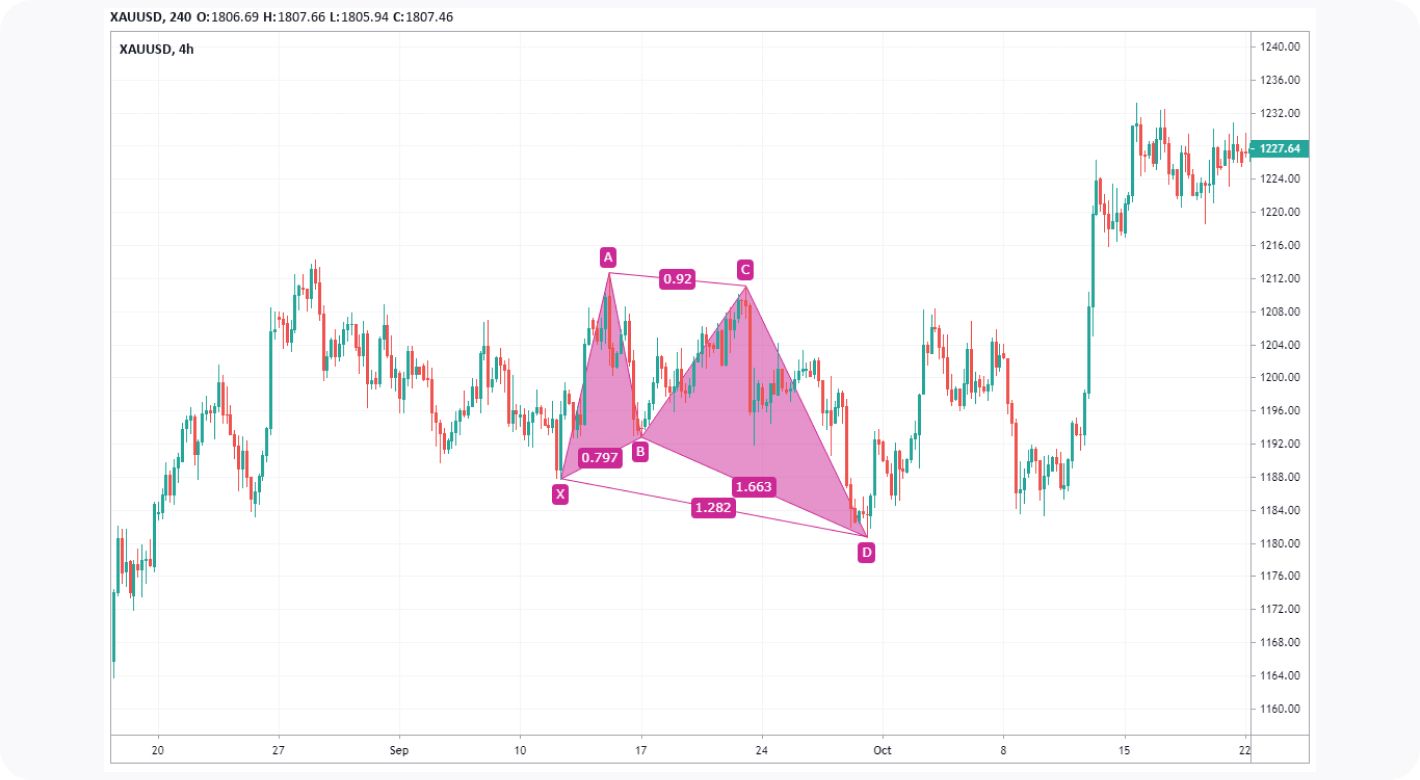FXOpen

One of the important skills for Forex trading is the ability to read patterns. There are many harmonic patterns. The most popular ones are bat, crab, shark, the Gartley, and butterfly.
The butterfly pattern is known as one of the most developed and complicated reversal patterns that appear at the end of a trend. If used correctly, it is also known to be reliable and precise. Read more to learn how to use it on FXOpen.
What Is a Butterfly Pattern?
The butterfly chart pattern is a reversal figure with a butterfly-like shape which is a part of the harmonic group. It helps to identify the ending of a solid trend and allows traders to enter the market at the very beginning of a new one. There are bullish or bearish butterflies:
- The bullish butterfly harmonic pattern appears at the end of a downtrend and provides buy signals.
- The bearish butterfly pattern is formed at the end of an uptrend and provides sell signals.
Benefits and Drawbacks
Since the butterfly pattern gained worldwide recognition, it is clear that it has benefits for traders, which include:
- It is easy to identify if a trader follows predetermined rules. For those traders who don’t know how Fibonacci retracements and extensions work, the butterfly formation is an unassailable fortress, but those who know how the tools work, apply this setup constantly.
- It offers strong indications. The butterfly pattern on Forex is considered to be one of the more precise and consistent sources of trading signals.
As with all other schemes, the Butterfly also has some downsides that traders should be aware of. They include:
- Broad forex analysis knowledge is required. Traders usually combine the pattern with other indicators and chart figures to confirm signals and entry/exit points.
- Its structure can be a burden. Traders often practise on a demo account and learn how to apply the Fibonacci retracement before using Harmonics. Without practising, traders may end up being disappointed and frustrated by the failed implementation of the full figure.
- It is less often identified than the Gartley. For some traders, it is more convenient and practical to use the Gartley than the butterfly formation. It is so because the Gartley offers similar signals and can be spotted more frequently.
Ways to Spot and Use a Butterfly Pattern in Forex Trading
Let’s consider how a trader can spot and trade the Butterfly pattern.
How to Identify
The butterfly harmonic pattern has a structure of four legs — XA, AB, BC, and CD, which make up three swings, and five points — X, A, B, C, and D.
The Butterfly formation is built on the following parameters. Only by using them will a trader find the pattern on a chart.
- The XA line is where the pattern begins.
- The CD leg exceeds X; D is either equal or exceeds B.
- The AB line doesn't exceed X, while the BC leg doesn't exceed A.
- B isn’t located higher than at 78.6% retracement of the XA line, and C lies at 38.2%-88.6% retracement of AB.
- D is at the 127.2%-161.8% extension of the XA line or at the 161.8%-261.8% extension of AB.
- CD and D confirm if the price starts a new trend.

How to Use
Overall accuracy is paramount when it comes to using butterfly setups because it allows the trader to rule out mistakes. There are a few steps to take for using the butterfly harmonic reversal pattern on a price chart:
- Traders analyse the chart and find a figure with two decreasing highs and two decreasing lows or with two increasing highs and two increasing lows — these are bullish and bearish Butterflies respectively.
- After, traders apply the Fibonacci tool to specified legs and determine the following points.
- To enter a trade, they look for a confirmation of a trend reversal — C shouldn’t exceed A.
- Traders usually use B and C as profit objectives.
- X is a common stop-loss level.

These are general rules for trading bearish and bullish Butterflies include:
|
Bearish |
Bullish |
|
|
Entry point |
Point D |
Point D |
|
Take Profit |
The theory suggests a trader places a take-profit order at the A point (aggressive approach) or B (defensive approach). Also, it would be possible to partially take profit at 61.8% and 127.2% of the CD leg. |
The theory suggests a trader places a take-profit order at the A point (aggressive approach) or B (defensive approach). Also, it would be possible to partially take profit at 61.8% and 127.2% of the CD leg. |
|
Stop Loss |
Traders could consider the risk/reward ratio of 1:2 or 1:3 as a stop-loss target. |
Traders could consider the risk/reward ratio of 1:2 or 1:3. |
Takeaway
Chart shapes are crucial trading tools for traders of any level. They play a key role when it comes to signalling a reversal or continuation of the current trend, as well as determining entry and exit points for a position.
As for the butterfly, when applied correctly, it is an effective tool for predicting future prices with potentially some probability. All these factors make butterfly patterns an irreplaceable part of Forex market trading. You can try to find them on the TickTrader platform.
This article represents the opinion of the Companies operating under the FXOpen brand only. It is not to be construed as an offer, solicitation, or recommendation with respect to products and services provided by the Companies operating under the FXOpen brand, nor is it to be considered financial advice.
Stay ahead of the market!
Subscribe now to our mailing list and receive the latest market news and insights delivered directly to your inbox.








